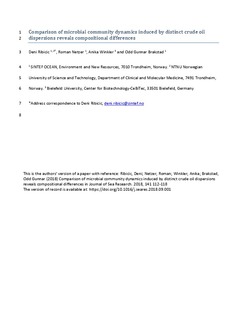| dc.contributor.author | Ribicic, Deni | |
| dc.contributor.author | Netzer, Roman | |
| dc.contributor.author | Winkler, Anika | |
| dc.contributor.author | Brakstad, Odd Gunnar | |
| dc.date.accessioned | 2019-06-21T08:23:47Z | |
| dc.date.available | 2019-06-21T08:23:47Z | |
| dc.date.created | 2018-10-11T15:19:46Z | |
| dc.date.issued | 2018-11 | |
| dc.identifier.citation | Journal of Sea Research. 2018, 141 112-118. | nb_NO |
| dc.identifier.issn | 1385-1101 | |
| dc.identifier.uri | http://hdl.handle.net/11250/2601640 | |
| dc.description.abstract | To understand the impact of oil contamination on marine microbial communities, numerous studies have been conducted following microbial dynamics after oil spills and concerning the effects of different environmental parameters on oil biodegradation potential. Nevertheless, there is a lack of understanding of how distinct oil crude types might influence the dynamics of microbial communities of identical origin. Here we show that different crude oils affect the community composition by shaping it distinctly over the course of incubation. We have used chemical dispersion of three crudes with different properties (paraffinic, paraffinic-asphaltenic and naphthenic). Oceanospirillaceae, Colwelliaceae, Porticocacceae, Flavobacteriaceae and Piscirikettsiaceae were highly abundant in all three oil dispersions. However, comparing group distances of the communities at each time point, as well as pairwise fold comparison of OTUs, has revealed significant differences in microbial composition between the oils (p < 0.05), but also between the major families related to biodegradation (p < 0.01). Furthermore, the PAH degradation rates proved to be significantly higher in naphthenic oil (p < 0.05), while the n-alkane degradation was slower, however not significant (p > 0.05). We conclude that different crude oils can shape microbial community distinctively over exposure time, therefore altering community biotransformation potential and causing different degradation rates of targeted oil compounds. | nb_NO |
| dc.description.sponsorship | This study is a part of a project which is funded by The ResearchCouncil of Norway (project # 22827/E30: Oil Spill DispersantStrategies and Biodegradation Efficiency) and the oil companies Statoil ASA, AkerBP ASA, ExxonMobil Production Norway Inc., Total E&P and ConocoPhillips Skandinavia AS. | nb_NO |
| dc.language.iso | eng | nb_NO |
| dc.publisher | Elsevier | nb_NO |
| dc.rights | Attribution-NonCommercial-NoDerivatives 4.0 Internasjonal | * |
| dc.rights.uri | http://creativecommons.org/licenses/by-nc-nd/4.0/deed.no | * |
| dc.title | Comparison of microbial community dynamics induced by distinct crude oil dispersions reveals compositional differences | nb_NO |
| dc.type | Journal article | nb_NO |
| dc.type | Peer reviewed | nb_NO |
| dc.description.version | acceptedVersion | nb_NO |
| dc.source.pagenumber | 112-118 | nb_NO |
| dc.source.volume | 141 | nb_NO |
| dc.source.journal | Journal of Sea Research | nb_NO |
| dc.identifier.doi | 10.1016/j.seares.2018.09.001 | |
| dc.identifier.cristin | 1619761 | |
| dc.relation.project | Norges forskningsråd: 228271 | nb_NO |
| cristin.unitcode | 7566,6,0,0 | |
| cristin.unitname | Miljø og nye ressurser | |
| cristin.ispublished | true | |
| cristin.fulltext | postprint | |
| cristin.qualitycode | 1 | |

